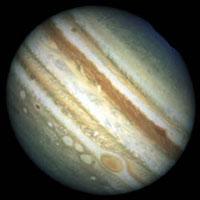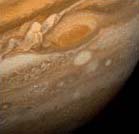Een Rode Vlek draait op Jupiter rond (Dutch)
A.L.P.O. Jupiter Alert
2002 January 26 / 2002 February 08
A consensus seems to be forming, within the amateur and professional
astronomy communities, that south temperate oval BA should be expected to
survive its conjunction with the GRS. Although BA may be affected in several
ways, it will probably, according to Dr. Reta Beebe, be slowed somewhat then
quickly be propelled past the GRS.
The visual appearance of BA being split or piled up on another oval was
simply other cloud material circulating around BA, and being compressed
between BA and the GRS currents.
Even though BA may not be disrupted, observers must remain alert. Jupiter
has surprised us in past apparitions.
It is important to obtain visual observations documented with disk sketches
or strip sketches depicting the GRS and BA interaction, CCD images, or
visual central meridian transit timings. These kinds of observations should
continue well after BA has passed the GRS.
The professional community is especially interested in any CCD images
obtained in methane.
CCD images and scanned sketches may be sent to at
John W. McAnally. Or mailed USPO
to 2124 Wooded Acres, Waco, Texas, USA
76710. We can also provide A.L.P.O. observing forms.
John W. McAnally
The A.L.P.O. Jupiter Section
Assistant Coordinator
Transit Timings
SpaceWeather.com
What's Up in Space -- 29 Jan 2002

JUPITER STORMS
Something extraordinary is happening on the planet Jupiter in full view of
amateur astronomers: Two gigantic storms are colliding. One is a "white oval"
-- a 70-year old hurricane nearly the size of Earth. The other is the famous
Great Red Spot -- a centuries-old tempest twice as wide as our planet.
The pair will likely converge during the weeks ahead, but it will not be a
head-on collision because the two storms circle the planet at slightly different
latitudes. Nevertheless, the encounter should be dynamic and entertaining. Sky
watchers with 6" to 10" telescopes can view the action on clear nights with
good atmospheric seeing. Consult a table of Great Red Spot transit times to
decide when to look.
SpaceWeather.com
What's Up in Space -- 1 Jan 2002
NEW YEAR, GIANT PLANET
The giant planet Jupiter and our own planet Earth will have a close encounter on the first day of the New Year. The two worlds will lie just 4.19 astronomical units apart when Jupiter reaches "opposition" -- that is, a point in the sky directly opposite the Sun -- on January 1, 2002. New Year's Eve revelers in the northern hemisphere can easily find the planet. Simply look straight overhead at midnight: there lies Jupiter -- the brightest "star" in the sky.
Finder chart

=====================================================================
SKY & TELESCOPE'S NEWS BULLETIN - DECEMBER 28, 2001
=====================================================================
For images and Web links for these items, visit http://www.skypub.com
=====================================================================
JUPITER'S SHRINKING RED SPOT
Telescopic observers from the 19th century may not have had the
technological wizardry available to modern-day skywatchers -- but they
apparently had an easier time spotting Jupiter's signature feature,
its Great Red Spot. According to Amy Simon-Miller (NASA/Goddard Space
Fight Center), today this giant cyclonic storm is only about half as
big as it was in the 1880s. Simon-Miller and three colleagues
confirmed the shrinkage during a careful comparison of historical
records and contemporary images from the Voyager, Galileo, and Cassini
spacecraft. She presented their results last month at a meeting of
planetary scientists.
Astronomers have known since the early 1900s that the Great Red Spot's
longitudinal extent has been decreasing. Late in the 19th century the
spot was nearly 35 degrees wide, which corresponds to about 40,000
kilometers, or more than three times Earth's diameter.
By 1979, when Voyagers 1 and 2 swept past, it had shrunk to 21 degrees
(about 25,000 km), yet its latitudinal "height" remained essentially
unchanged, about 12,000 km from top to bottom.
Simon-Miller has discovered that the contraction seems to have picked
up steam since the Voyager visits: at its present rate of shrinkage
(0.19 degree in longitude per year), the spot will become the "Great
Red Circle" by the year 2040. However a perfectly round shape is
unlikely, she explains, because the strong, opposing jet streams that
confine the spot's northern and southern boundaries will always
distort it into an oval.
No one knows why the not-so-Great Red Spot has shrunk -- or, for that
matter, why its color intensifies and fades over time. One clue is
that the winds around its circumference are whirling 70 percent faster
now (about 700 km per hour) than they were in the Voyager era. Some
historical observations suggest that the Red Spot grows and shrinks in
a decades-long sequence. "I'm not sure the behavior is really
cyclical," Simon-Miller comments, "but I certainly would not be
surprised in the least if this shrinking trend slowed or reversed."
One possible explanation is that deep-seated bursts of
thunderstorm-like convection periodically energize the overlying cloud
layers, causing the spot to bloat in size, then gradually contract as
the turbulence subsides. "All of the weather on Jupiter seems to have
sporadic increases in activity," she notes, "so whatever feeds the
Great Red Spot likely will too."
=====================================================================
Copyright 2001 Sky Publishing Corporation. S&T's Weekly News Bulletin
and Sky at a Glance stargazing calendar are provided as a service to
the astronomical community by the editors of SKY & TELESCOPE magazine.
Widespread electronic distribution is encouraged as long as these
paragraphs are included. But the text of the bulletin and calendar may
not be published in any other form without permission from Sky
Publishing (contact permissions@skypub.com or phone 617-864-7360).
Updates of astronomical news, including active links to related
Internet resources, are available via SKY & TELESCOPE's site on the
World Wide Web at http://www.skypub.com/.
ROYAL ASTRONOMICAL SOCIETY
31st March 1998
OXFORD SCIENTISTS UNCOVER THE STRANGE WORKINGS
OF JUPITER'S GREAT RED SPOT - AND OTHER SECRETS OF
THE JOVIAN ATMOSPHERE
For well over two years, scientists from the department of
Atmospheric, Oceanic & Planetary Physics at Oxford University
have been studying weather and cloud formations on a world
more than 600 million km away - the planet Jupiter. The latest
results of their research will be presented at the UK National
Astronomy Meeting on Tuesday 31st March by Professor Fred
Taylor, co-investigator for the NIMS instrument on the Galileo
spacecraft, which is currently orbiting Jupiter. These results
include the revelation of remarkable structure in Jupiter's Great
Red Spot.
The giant planet Jupiter is famous for its colourful, swirling
clouds. The most notable feature among this ever-changing
turbulence is the Great Red Spot, a huge storm system that could
swallow up three Earths and is known to have existed for at least
three centuries.
One of the instruments on board the Galileo orbiter being used
to study the Jovian atmosphere and the Great Red Spot is the
Near-Infrared Mapping Spectrometer (NIMS). The capability of
NIMS to obtain spatial and spectral information simultaneously
is ideal for investigating the composition, vertical layering,
optical thickness, and fine structure of Jupiter's mysterious cloud
layers. The scientists hope that continued observations with
NIMS will help to explain a number of the following mysteries:
1) Although theories abound, it is still not known what gives
rise to the bright colorations of the Jovian clouds - for example,
the red pigment in the Great Red Spot or the various yellows
and browns.
2) The nature of the circulation which gives rise to the east-west,
belt-zone cloud structure is controversial.
3) What creates and sustains the various giant weather systems
(of which the Great Red Spot is just one example of a whole
family of different types of giant eddies).
The analysis of the data is still at a relatively early stage, but
several preliminary results will be presented at NAM.
WINDS, STORMS AND THE GREAT RED SPOT
Jupiter has high winds, and a large number of very large, very
long-lived storm systems can be seen on the planet at any one
time. The most famous of these is the Great Red Spot (GRS),
which is revealed as having a most remarkable structure in the
new data. Most astronomers believed it was a deep mass of
cloud. Instead, it has a spiral arm structure of clouds, with gaps
between which enable NIMS to see through the GRS into the
deep, relatively clear atmosphere below. Futhermore, the cloud
structure is higher in the centre by more than 10 km and tilted
towards one side, something like a crooked spiral staircase. What
seems to be happening is that wet air from the deep atmosphere
is rising rapidly in a relatively narrow region in the centre of the
GRS, and then spraying out above the tops of the ammonia
clouds while rotating, rather like a giant garden sprinkler . In
some ways this is similar to what happens in a terrestrial
hurricane, but the Jovian storm is much bigger than the entire
Earth.
THE NATURE OF JUPITER'S CLOUD LAYERS
As expected, the main cloud layer on Jupiter is made up of
frozen ammonia crystals, and lies at a pressure level of around
half a bar (1 bar is the mean pressure at the surface of the Earth).
Although anticipated to resemble terrestrial cirrus clouds, the
Jovian, ammonia-ice version is made of particles around a
hundred times smaller than those in water-ice clouds on Earth.
The ammonia clouds are overlain by a thick haze at much
higher levels in Jupiter's atmosphere. This appears to be a
photochemical smog made up of liquid hydrocarbon droplets. A
similar layer blankets Saturn's moon Titan and prevents us
from seeing Titan's surface. Although thinner than Titan's, the
Jovian haze is unexpectedly substantial, and varies with time
and place across the planet.
There is a thicker cloud layer below both the haze and the
ammonia cloud. This may be the theoretically-predicted
hydrogen sulphide (as NH4SH) cloud at around the one-and-a-
half bar level (one and a half times the sea level air pressure on
Earth), or a combination of that and an even deeper water cloud.
New data is being acquired to try to resolve this point.
THE COMPOSITION OF JUPITER'S ATMOSPHERE
Jupiter's atmosphere is mainly hydrogen, with about 15%
helium and a number of minor constituents, the most
important of which are measured and mapped by NIMS.
Weather on Earth centres around the condensation and
evaporation of water. On Jupiter three species, ammonia,
phosphine, and water vapour, can condense, making for a
remarkably complicated climate. The new data have shown that
water, in particular, is very variable. This helps explain the very
low water abundance measured by the Galileo probe when it
plunged into Jupiters clouds in December 1995. It happened, by
chance, to enter a particularly dry region.
NOTES
The Oxford researchers are part of an international science team
for the Near Infrared Mapping Spectrometer on the Galileo
orbiter (Principal Investigator is Dr. Robert W. Carlson of the Jet
Propulsion Laboratory in Pasadena, California).
Galileo is a $1.5 billion NASA mission to explore the Jupiter
system at close quarters over a long period. The orbiter has been
returning data on the planet and its four largest moons since 7
December, 1995. A probe was also released into Jupiter's
atmosphere which returned unique information on the
structure and composition of the planets cloud layers. Although
the primary mission is now over, the orbiter and the NIMS
experiment are in good health and an extended mission is under
way. This is focusing on detailed studies of the icy satellite
Europa, which is thought to have a sub-surface ocean.
IMAGES
NIMS images showing full hemisphere views of Jupiter are
available on the Web site at:
http://www.atm.ox.ac.uk/user/irwin/NIMS.html
 Back to ASTRONET's home page
Back to ASTRONET's home page
 Terug naar ASTRONET's home page
Terug naar ASTRONET's home page


 Back to ASTRONET's home page
Back to ASTRONET's home page Terug naar ASTRONET's home page
Terug naar ASTRONET's home page